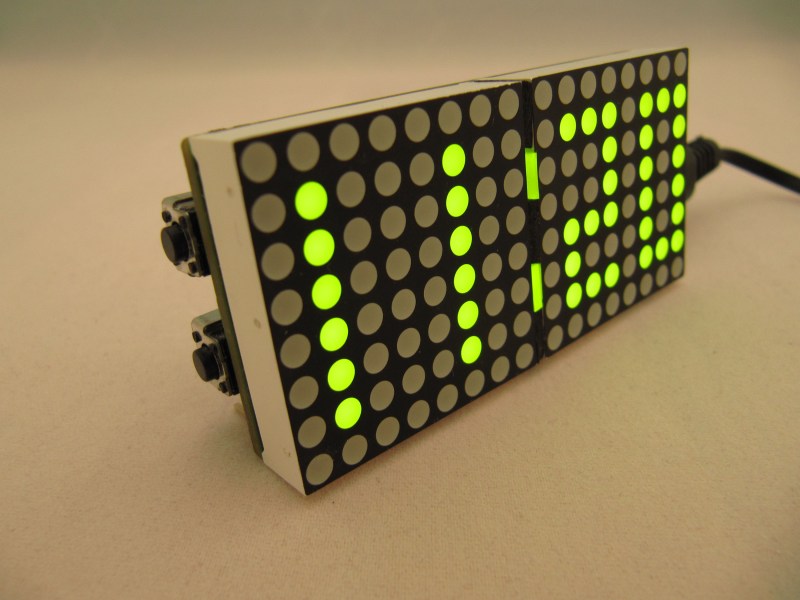We’re surprised we haven’t seen this kind of clock before, or maybe we have, but forgot about it in the dark filing cabinets of our minds. The above picture of [danjhamer’s] Matrix Clock doesn’t quite do it justice, because this is a clock that doesn’t just tick away and idly update the minutes/hours.
![]()
Instead, a familiar Matrix-esque rain animation swoops in from above, exchanging old numbers for new. For the most part, the build is what you would expect: a 16×8 LED Matrix display driven by a TLC5920 LED driver, with an Arduino that uses a DS1307 RTC (real-time clock) with a coin cell battery to keep track of time when not powered through USB. [danjhamer] has also created a 3D-printed enclosure as well as added a piezo speaker to allow the clock to chime off customizable musical alarms.
You can find schematics and other details on his Hackaday.io project page, but first, swing down below the jump to see more of the clock’s simple but awesome animations.

















Animatoin effect request:
It could play pong and miss a shot showing the time as a score
I’ll add it to the list for the next firmware update.
Got one on order, should arrive when i get back from holidays.
I like it because it has everything you need (leds, mcu, power, rtc, buttons). I might add a temperature sensor but that’s it.
Imho it’s a bit pricey for that hardware but to be fair the documentation/software are above the average.
The first alarm is theme from Red Dwarf. :)
You got it :0). Did you guess the other two?
other one is portal still alive, btw: arduino = shit
Hmm, these TLC5920s are interesting. Cheaper than genuine MAX7219s, although it seems that you need to do your own row scanning.
In the video it appears as if some LEDs were driven at half brightness. Was this programmed that way or is this an effect of the low framerate of the video in combination with the animation pattern?
Erm, what are you talking about? The TLC5920 is in no way a clone or copy of the MAX7219. It is designed to control 16 LEDs with 8 bit PWM. The MAX7219 is designed to control an 8×8 matrix with on/off only.
Sorry, I see that using the word “genuine” was confusing. I meant: MAX7219 is also used to 8×8 led matrices. If you buy the genuine MAX7219, as opposed to the cheap ones from ebay, they are a lot more expensive than the TLC5920.
I understand the differences between these ICs. The MAX7219 holds the bit patterns for 8×8 LEDs, while the TLC5920 holds the pattern for 16 LEDs and additionally allows controlling 8 “row select” (my words) lines. The TLC5920 therefore requires you to send the bit pattern for each 16 led “row” in quick succession. On the other hand, the TLC5920 allows more control over the duty cycle for each LED (MAX7219 allows control of the duty cycle for the whole matrix in 16 steps).
I was wondering whether I was seeing that control over the duty cycle in the video or whether the “half brightness” LEDs shown in the video where an artifact of the framerate of the video.
Thanks for your interest in my clock. I chose the TLC5920 because it offered the best solution for the kind of animated graphics I wanted to do at a reasonable cost. It latches the 16 bits but you do need to do row scanning. I tend to favor TI parts because they offer great performance and features at a reasonable cost. Maxim parts are fantastic but hard to source and a little on the expensive side. The shading is a feature of the driver I wrote for the TLC5920 and not a video artifact. I think shading offers a greatly enhanced graphics capability.
Duty cycle control, they call it shading. You could take a look at the code, they have it on their website.
I am the product line manager at Maxim supporting the MAX7219 and similar products and am a Huge Hackaday fan. I just developed two Arduino compatible (Uno and Mega) driver boards using MAX7219s. This should be available on the Maxim site in a few weeks with full code samples.
I don’t want this comment to be a TI vs. Maxim dialogue – you come to your own conclusions on which part suits your application. TI makes decent parts. But for this application, the 7219 is ideally suited for the maker, since it drives the LED matrix directly – and it comes in a DIP package. Keep in mind that you can sample free parts for personal projects. :-)
Hackaday rocks.
If you like this clock have a look at http://timewitharduino.blogspot.com/2012/06/animation-on-wise-clock-34.html
A bit more expensive but lots of options, animations, internet access etc. etc.
Seed Studio commercial.
Not a hack and not really interesting.
Why do you even come here? This a pretty neat, and he published the entire design on his website, including the firmware. All this ‘not a hack’ stuff is crap. please define what a ‘hack’ is….
Might want to fix up the units. RTTC and its crystal are 32.768kHz (not MHz)
BTW there is also a lattice clock from China – $13 with four 8×8 matrix and Atmega8. If you can’t/don’t want to built your own. google for “JY-MCU 3208 Lattice Clock” Someone has reverse engineered it with schematic and open source firmware.
Damn, Christmas is over and now I’ve found a watch I want!
Just may have to steal this one to make my clocks. I have a pile of red 8×8 with the same pinouts.